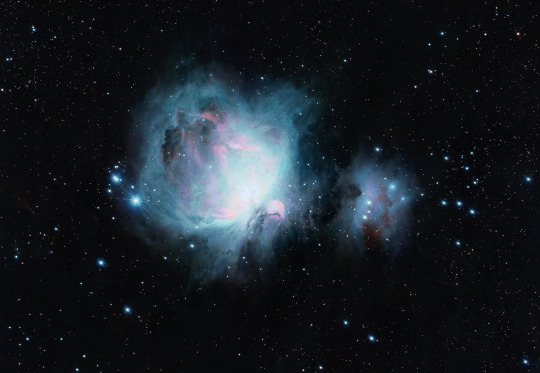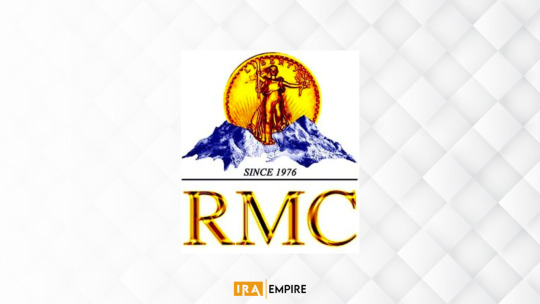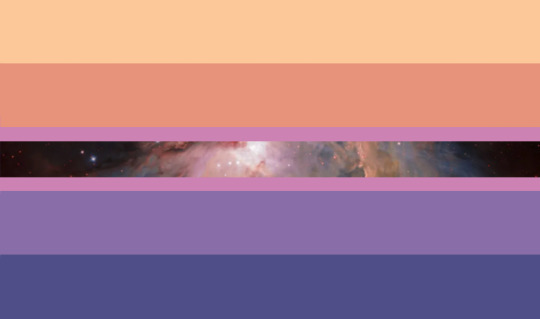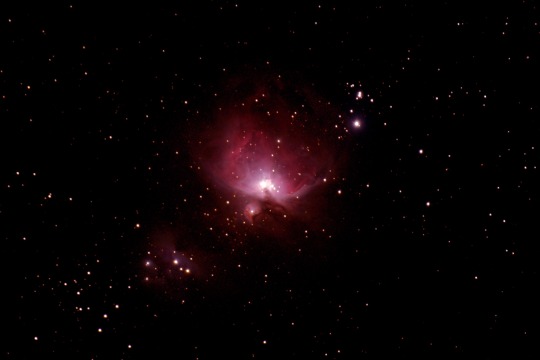#NGC 1976
Explore tagged Tumblr posts
Text

The Orion Nebula (M42, left), De Mairan's Nebula (M43, below center), and the Running Man Nebula (Sh2-279) // rmatscott
#astronomy#astrophotography#nebula#emission nebula#star-forming region#orion nebula#de mairan's nebula#running man nebula#messier#messier 42#M42#messier 43#M43#NGC 1976#Sh2-281#NGC 1982#NGC 1973#NGC 1975#NGC 1977#Sh2-279#orion
174 notes
·
View notes
Text

The Orion Nebula - Discovered by Nicolas-Claude Fabri de Peiresc (1610)
#1610#2006#science#astronomy#Orion Nebula#Nicolas-Claude Fabri de Peiresc#M42#Messier 42#NGC 1976#Orion#Milky Way#Hubble Space Telescope#NASA
48 notes
·
View notes
Text


Orion Nebula
NGC 1976
286 notes
·
View notes
Text

Waxing crescent moon high in the sky at 8:15PM EST time!

Sorry for the low quality on this, but my hands were shakey and this was the best I could do!
The Orion Nebula, NGC 1976, 8:00PM EST time!
61 notes
·
View notes
Text
The Great Orion Nebula

The Great Orion Nebula, also known as Messier 42 (M42) or NGC 1976, is one of the most spectacular and well-studied star-forming regions in our sky. Here are some key points about this celestial marvel:
Location and Visibility: It's located in the constellation of Orion, specifically in the sword of Orion, below Orion's Belt. It's visible to the naked eye as a fuzzy patch, but binoculars or a small telescope reveal its intricate beauty.
Distance: The nebula is approximately 1,344 light-years from Earth. This distance means we're looking back in time when we observe it, seeing it as it was over 1,300 years ago.
Structure: The Great Orion Nebula is an enormous cloud of gas and dust where stars are born. It's part of a larger complex known as the Orion Molecular Cloud Complex. M42 itself spans about 24 light-years across. The nebula's core is illuminated by a cluster of young, hot, massive stars known as the Trapezium Cluster, which lights up the surrounding gas, making it glow.
Star Formation: This region is a stellar nursery, where new stars are still forming. The nebula contains thousands of young stars, many of which are hidden by the dense dust clouds but can be detected in infrared light. The process of star formation here includes the collapse of gas and dust into protostars, which then evolve into main-sequence stars.
Historical Observations: The nebula has been known since antiquity, but it wasn't until the invention of the telescope that its nature was better understood. Galileo was one of the first to observe it through a telescope in 1610, describing it as a bright patch.
Scientific Importance: Studying the Great Orion Nebula helps astronomers understand star formation, the life cycles of stars, and the chemistry of interstellar space. It's a prime example for studying how solar systems like ours might have formed.
Aesthetic: Photographically, the Great Orion Nebula is one of the most photographed objects in the sky due to its beauty and detail. It shows off vibrant colors from hydrogen (red), oxygen (blue), and sulfur (green), among other elements, when viewed through appropriate filters.
Grok AI
This publication is an example of how Grok AI can briefly and succinctly tell about popular astronomical objects. But his story requires at least one clarification: Galileo Galilei really looked through a telescope to where the Orion Nebula is located, but he did not notice the nebula - the optics of his telescope were too weak for such observations - not high-aperture. But he noted the triplicity of the star Theta Orionis, located in the very center of the nebula. Now we know that this star system has at least 16 components and is a small open star cluster.
The ancient civilizations of Greece and Rome also did not know about the Orion Nebula. But the Maya Indians knew about it in the era of antiquity (although this is only an assumption based on the study of Myths). The first European who actually saw the Orion Nebula was Nicolas-Claude Fabri de Peiresc. This happened at the very end of 1610.
And finally, a short video based on an amateur astrophoto of the Orion Nebula taken by Lisa Bromfield:
youtube
7 notes
·
View notes
Text

The Orion Nebula (also known as Messier 42, M42, or NGC 1976) is a diffuse nebula situated in the Milky Way, being south of Orion's Belt in the constellation of Orion. It is one of the brightest nebulae, and is visible to the naked eye in the night sky. M42 is located at a distance of 1,344 ± 20 light years and is the closest region of massive star formation to Earth. The M42 nebula is estimated to be 24 light years across. It has a mass of about 2,000 times that of the Sun. Older texts frequently refer to the Orion Nebula as the Great Nebula in Orion or the Great Orion Nebula.
The Orion Nebula is one of the most scrutinized and photographed objects in the night sky, and is among the most intensely studied celestial features. The nebula has revealed much about the process of how stars and planetary systems are formed from collapsing clouds of gas and dust. Astronomers have directly observed protoplanetary disks, brown dwarfs, intense and turbulent motions of the gas, and the photo-ionizing effects of massive nearby stars in the nebula.
The data set used to create this image consisted of several different exposure length times to help keep the core from blowing out.
HA 20x600 seconds, HA 10x30 seconds
RGB 12x300 seconds
9 notes
·
View notes
Text

Backyard view of the Orion Nebula in hydrogen-alpha (M42, NGC 1976) along with De Mairan's Nebula (M43, NGC 1982), the Running Man nebula (NGC 1977, Sh 2-279), along with a bunch of other deep sky wonders, LBN 977, IC428, IC420.
2 notes
·
View notes
Text
Rocky Mountain Coin Inc

What is Rocky Mountain Coin Inc?
Rocky Mountain Coin Inc is a rare coin, money, and precious metals trader located in the centre of Denver, Colorado. Rocky Mountain Coin Inc, founded in 1976, has grown to become one of the country's largest dealers. Managing annual transactions involving millions of dollars in coins, banknotes, and precious metals. In addition to coins, Rocky Mountain Coin also buys and sells gold jewellery, pre-owned Rolex watches, and various other valuables. RMC is also a leading reseller of Garrett and Minelab metal detectors in Colorado.

Rocky Mountain Coin Inc has always operated under the tenets of fairness and integrity. Proudly upholding a reputation for great service, knowledge, and unrivalled professional standards. Rocky Mountain Coin Inc is the destination for investment in retirement saving options. Whether you are a collector of rare coins or uncommon currencies or investing in physical assets. The company trades every day at the most affordable pricing. Perhaps you would like to sell and transform into cash a collection of antique rare coins, money, or bullion. You might choose to invest in precious metals or start a collection of rarer coins. Rocky Mountain Coin Inc will provide you with a great bargain and a wide variety of bullion goods to pick from. In the state of Colorado, Rocky Mountain Coin Inc is the biggest of its kind. Their business moves goods often, so there is always something new in our stores. Ro The American Numismatic Association (ANA), Numismatic Guaranty Corporation (NGC), Professional Coin Grading Service (PCGS), and Industry Council for Tangible Assets (ICTA) are among the other professional numismatic associations that Rocky Mountain Coin Inc belongs to. Additionally, the Better Business Bureau has given Rocky Mountain Coin an A+ rating. For detailed information Read Rocky Mountain Coin Reviews.
Rocky Mountain Coin Inc- Coins
Rocky Mountain Coin Inc actively buys and sells these things every day and has thousands of rare and valuable U.S. And international coins that date from antiquity to the present era in RMC inventory.

The company welcomes people’s calls whenever they have questions. Regardless of where people are in Colorado, the United States, or the rest of the world. Rocky Mountain Coin Inc experienced professional numismatists are happy to help people in all honesty and integrity and without pressure.
Rocky Mountain Coin Inc- Currency
From the Ming Dynasty to the present, Rocky Mountain Coin Inc stocks hundreds of rare and collectible pieces of American and international paper money.

Economic factors during the American Civil War caused a shortage of gold and silver coins. Which were therefore hoarded for their bullion worth rather than their face value. The U.S. Treasury developed fractional currency to fend against currency speculation (and to provide a way of giving out little change). The 3, 5, 10, 15, 25, and 50 notes were initially given as postal currency to be exchanged for postage stamps between 1862 and 1876. National Bank Notes National banks chartered by the US government issued banknotes denominated in US dollars known as National Bank Notes. The bonds that the bank placed with the US Treasury often served as the notes' security. In addition, banks had to have a redemption reserve in gold or "lawful money" equal to 5% of any outstanding note balance. Although not generally accepted as legal cash, the notes were enough for almost all payments to and by the federal government. The United States government discontinued the use of National Bank Notes as a form of currency in the 1930s, when silver certificates, Federal Reserve Notes, and United States Notes replaced them. Gold Certificates Instead of storing the actual gold, gold owners hold a gold certificate as proof of ownership. It has historical significance as American paper money (1863–1933) as well as contemporary significance as a means of investing in gold. For gold that is allotted (non-fungible) or unallocated (fungible or pooled), banks may issue gold certificates. In the case of a run on the gold on deposit at the issuing bank, unallocated gold certificates, a type of fractional-reserve banking, do not ensure an equal exchange for metal. Although it might be challenging to tell whether a bank is inappropriately allocating a single bar to many parties, allocated gold certificates should be associated with particular numbered bars. Silver certificates Silver certificates are a sort of representational currency that was circulated in the United States between 1878 and 1964. They were created in response to public outrage over the Fourth Coinage Act, which effectively put the US on the gold standard, and in response to public demand for silver. The certificates could be redeemed for their face value in silver dollar coins at first, and then (for a year, from June 24, 1967, to June 24, 1968) they could be redeemed for pure silver bullion. Although they are no longer acknowledged as legal tender because they can only be redeemed for Federal Reserve Notes after 1968, they are still valid legal tender at face value. Large-size silver certificates Large-size silver certificates (1878 to 1923) were issued initially in denominations from $10 to $1,000 (in 1878 and 1880) and in 1886 the $1, $2, and $5 were authorized. In 1928, all United States bank notes were re-designed, and the size reduced. The small-size silver certificate (1928–1964) was only regularly issued in denominations of $1, $5, and $10. The complete set is part of the National Numismatic Collection at the Smithsonian’s National Museum of American History. Federal Reserve Bank Notes Banknotes that were printed between 1915 and 1934 that are still accepted as legal tender in the US include United States Notes, Silver Certificates, Gold Certificates, National Bank Notes, and Federal Reserve Notes. They were outlined in the Federal Reserve Act of 1913 and were equal in value to other notes of a like denomination. In contrast to Federal Reserve Notes, Federal Reserve Bank Notes are backed by just one of the twelve Federal Reserve Banks, as opposed to all of them combined. Transparency is Important National Bank Notes were intended to be replaced with Federal Reserve Bank Notes, but this did not turn out to be the case. They were issued by Federal Reserve banks as opposed to National Banks but were backed similarly to National Bank Notes by U.S. bonds. Federal Reserve Bank Notes are no longer printed; since 1971, only Federal Reserve Notes have been in circulation in the United States. Large Size Federal Reserve Bank First released in 1915 in denominations of $5, $10, and $20, large-size Federal Reserve Bank Notes shared design cues with both the Federal Reserve Notes and the National Bank Notes of the time. In 1918, additional $1, $2, and $50 bills were printed as a temporary replacement for Silver Certificates, which the Pittman Act had temporarily banned from use. Small Size Federal Reserve Bank Notes In 1933, small-size Federal Reserve Bank Notes were manufactured on the same paper stock as 1929 National Bank Notes as a temporary emergency issue. They were printed in amounts ranging from $5 to $100. A National Bank Note features a line for the president of the national bank to sign, but as Federal Reserve Banks had governors rather than presidents, this line was printed as a bar on the lesser size Federal Reserve Bank Note. After the sentence "Secured by United States bonds deposited with the Treasurer of the United States of America," the words "Or by like deposit of other securities" were added. The public's hoarding of currency as a result of numerous bank failures that were taking place at the time led to this emergency note issue. The National Banks' capacity to produce their own notes was likewise constrained by this. Federal Reserve Bank Notes in small size stopped being printed in 1934 and haven't been available in banks since 1945. They contain brown seals and serial numbers, just like the vintage National Bank Notes, which are modest size notes. Although they have the same wording "National Currency" at the top of the obverse and a very similar appearance, the bills were issued by different entities and are thought to be of entirely different kinds. Federal Reserve Notes The United States dollar is now printed on Federal Reserve Notes, often known as United States banknotes. The Federal Reserve Act of 1913 authorizes the United States Bureau of Engraving and Printing to print the notes. And at the Board of Governors of the Federal Reserve System's discretion, to issue them to the Federal Reserve Banks. The notes are subsequently distributed by the Reserve Banks to their member banks. At which time they are converted into Reserve Bank liabilities and US debt. The words "this note is legal tender for all debts, public and private" are printed on each Federal Reserve Note, making them valid forms of payment. They took the place of National Bank Notes, which national banks issued between 1863 and 1935. With permission from the US Treasury. The Federal Reserve Banks guarantee financial assets as collateral for the notes. Mostly Treasury securities and mortgage agency securities, which they buy on the open market with fiat money. United States Notes From 1862 through 1971, the United States issued United States Notes, sometimes referred to as Legal Tender Notes. They were released for a longer period of time than any other type of U.S. paper money, lasting 109 years. The name "greenbacks" came from the older greenbacks, the Demand Notes, which they succeeded in 1862. They are frequently referred to as Legal Tender Notes. Although the First Legal Tender Act, which approved them as a form of fiat money, was renamed the United States Notes. In the 1860s, the notes' alleged second duty read as follows on the back: This Note is payable in repayment of all loans made to the United States and is a legal tender for all debts, public and privat. With the exception of duties on imports and interest on the public debt. When compared to contemporary American currency, United States Notes issued in the large-size format prior to 1929 look very different. But those issued in the small-size format beginning in 1929 look very similar to modern Federal Reserve Notes of the same denominations, with the exception of having red U.S. Treasury Seals and serial numbers in place of green ones. The United States still recognizes existing United States Notes as legal tender; however, since no new United States Notes have been created since January 1971. They are become harder to find in circulation and are worth more as numismatic collectibles than their face value.
Bullion
If you're thinking about investing in silver or gold, visit Rocky Mountain Coin in Denver, Colorado, and Greenwood Village. We have been buying and selling gold, silver, and platinum coins and bars since 1976. Because we are one of the largest precious metals merchants in the country, you can expect affordable rates.

Rocky Mountain Coin Inc stocks thousands of bullion items because RMC is Colorado's largest precious metals exchange. If you're a Denver resident, From Littleton, Englewood, Arvada, Aurora, Centennial, or any other metropolis. You can reach RMC’s Denver or Greenwood Village store in about 30 minutes by car. >>>Get in touch with the #1 rated gold IRA company of 2023 Read the full article
0 notes
Photo

Giant Stars
112 notes
·
View notes
Text

✧。:*▹ Orionebulaic
[ PT: Orionebulaic end PT ]

✧ Orionebulaic is a SPAN nebulaic gender related to the Orion nebula, or M42 or NGC 1976. It is located near Orion’s belt in the constellation Orion.
✧ Pronouns can include:
ori/orion/orions/orions/orionself
neb/nebula/nebulas/nebulas/nebulaself
tap/tapestry/es/estrys/tapestryself

ID: a white DNI with a panel of the manga Oyasumi Punpun with 5 kids doing a joint pose. Words are black on the right side: “DNI: anti- ‘contradictory’ labels, anti-mogai, terf, gatekeeper, anti-decolonization, believes ‘narc abuze’ is real, demonizes ‘scary/evil’ disorders + labels.” End ID.
#Orionebulaic#orionself#nebulaself#tapestryself#lgbtqia+#mogai haven#mogai coining#liom coining#coined by me#new term#new flag#new gender#nox's terms#nox's flags#nox's hoard#fav flags#orion nebula#nebulaic#m47#ngc 1976#SPAN#spangender#has id#has pt
38 notes
·
View notes
Text

M42: The Orion Nebula! Fujifilm X-T4, XF 100-400mm, Skywatcher Star Adventurer 2i Pro. Only 11minutes of total integration time :)
Instagram | Twitter | Foundation
#m42#messier 42#Ngc 1976#DSO#deep sky object#astro observations#astrophotography#long exposure photography#photographers on tumblr#photography#fujifilm#fuji xt4#XF 100-400
153 notes
·
View notes
Photo



THE MANY GHOSTS OF DR. GRAVES #59 1976, Charlton Comics
I’m not sure who this art is. I thought it might be Peter Morisi’s, but it’s not quite right. And Charlton is not always great on those credits.
7 notes
·
View notes
Photo


#Orion Nebula#NGC 1976#Messier 42#nebula#space#astronomy#astrophotography#religion is a mental illness
20 notes
·
View notes
Photo

NGC 1976 - (M42) Orion Nebula In Oxygen Hydrogen & Sulphur
#NGC 1976#M42#Orion Nebula#nasa#stargazing#astrophoto#astrophotography#galaxy#astronomy#universe#space#nebula#spinningblueball#thespinningblueball#milky way#milky way galaxy#milkywaygalaxy#spacephotography#nightsky#starrynight#milkywayphotography#astrophotos#starscape#star#cosmos#telescope#hubble#chandra#spitzer#hubble telescope
230 notes
·
View notes
Photo

Chen Ting-Shih Day and Night #36A 1976 Woodblock
61 notes
·
View notes
Video
Nebulosa de Orión por José Miguel Martínez Por Flickr: 15 minutos de exposición, con seguimiento
Nueva entrada en mi blog: La gran nebulosa de Orión #M42 #Orión desde #Cantabria con seguimiento montura #Astrotrac #fotografonocturno #Cantabrianocturna #Compartecantabria #Cantabriaturismo #NosvemosenCantabria #Cantabriainfinita #Fotografianocturna
#2019#Orión#El Cazador#constelación de Orión#constelación#M42#Nebulosa de Orión#Cinturón de Orión#Messier 42#NGC 1976#la Gran Nebulosa de Orión#Canon 5D Mark II#Canon EF 100-400 mm F/4#5-5#6 IS USM#Foto José Miguel Martínez#jmmpereda@yahoo.es#José Miguel M.P.#Contacto: jmmpereda@yahoo.es#Photography José Miguel#photography J.M.#wwww.josemiguelmartinez.es#Fotografía José Miguel Martínez Pereda#fotografianocturna.net#www.fotografianocturna.net#www.cantabrianocturna.com#Fotografía Nocturna#Fotografía nocturna José Miguel Martínez#Cantabria#Fotografías de Cantabria
1 note
·
View note